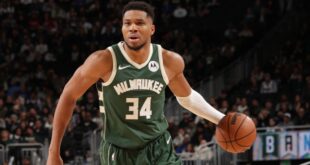CLEVELAND— The nature of NBA regular seasons depends largely on individual teams’ perspectives.
Take, for instance, the Cleveland Cavaliers’ abrupt exit from the 2025 playoffs on Tuesday evening. They fell to the Indiana Pacers, who clinched a spot in the conference finals by winning four out of the five games in the Eastern Conference semifinals, highlighted by a 114-105 victory at Rocket Arena.
The Cavaliers, much like the Oklahoma City Thunder in the Western Conference, powered through the season with remarkable consistency, achieving a 64-18 record and producing win streaks of 16, 15, and 12 games. In contrast, the Pacers found themselves as the No. 4 seed despite a decent, yet unremarkable 50-32 finish.
However, a closer examination reveals an interesting narrative. Indiana began the season with a rocky 5-10 record and faced numerous challenges—a demanding schedule, injuries, and a slower-than-anticipated performance from point guard Tyrese Haliburton—leaving them at 16-18 when 2025 began. They were trailing Cleveland by 13.5 games come New Year’s Day, without making any headway during the season.
Yet, they didn’t fall behind either. From January 1 to the conclusion of the season, the Cavs recorded 35 wins and 14 losses, while the Pacers matched that record with 34 wins and 14 losses.
“I feel bad their season had to conclude in this manner,” reflected coach Rick Carlisle. “Kenny [Atkinson, head coach of the Cavaliers] did an extraordinary job with his team. They had what you might call an ideal season. Then we showed up and caught fire.”
The Pacers didn’t receive the same recognition as the Cavs, Thunder, or Celtics, who all topped 60 wins because it took Indiana a couple of months to hit its stride.
Now, the Pacers find themselves back in the Eastern Conference finals for the second consecutive year. Here are five key takeaways from their decisive victory:
Describing the Pacers as a cohesive unit that outperforms their individual talents would be misleading, as their roster is abundant with skilled players. They possess depth comparable to the league’s finest teams, with 10 or 11 players excelling in specific roles.
However, there isn’t a leading MVP candidate on this team, nor is there a standout star. While Haliburton is a two-time All-Star and a key leader, the 31 points he scored on Tuesday marked the Pacers’ first 30-point outing of the playoffs. Some of his fellow players even regard him as (ahem) “overrated.”
“We’re unique compared to every other NBA team,” Haliburton stated. “There isn’t one player shouldering the scoring burden. We find ways to conquer opponents through various means. The ball circulates, and it locates the right shooters and playmakers.”
Carlisle added: “People often analyze playoff wins by highlighting impressive scoring displays and triple-doubles. However, defining moments in a series frequently stem from hustle plays for loose balls.”
Such moments were evident throughout the game, particularly as it progressed. Myles Turner’s chase-down block against De’Andre Hunter, Andrew Nembhard’s explosive drive along the left baseline, and Bennedict Mathurin’s rejection of a Donovan Mitchell layup were all critical plays.
In summary, the Cavaliers faced a disappointing end to what was a remarkable season for them. Three of their four losses in the playoff series occurred at home, and their star player, Donovan Mitchell, has yet to experience a conference finals. This was not how they envisioned concluding the prior six months as they breezed through the regular season.
Mitchell was taken aback by the outcome, and after the final buzzer, he returned to the arena to acknowledge the disheartened fans, visibly sharing their disappointment.
“I just couldn’t accept it. I still can’t believe it,” Mitchell expressed. “I thrive in that arena, the energy, the crowd. We lost three at home, and in doing so, we let the city down.
“You all might write us off, but we will return. We let our city and each other down, but we’ll be back.”
With Cleveland eliminated in the semifinals, is it justified to label them a regular-season team that falters in the playoffs?
The Pacers experienced a tough first quarter, being outscored 31-19, but the Cavaliers continued their momentum into the second quarter, establishing a 19-point lead at 44-25. Indiana fought back, closing the gap to four by halftime, which gave them a boost—until they faltered again.
Coming out of halftime, the Pacers struggled to execute a play and turned the ball over. Cavaliers guard Darius Garland maneuvered around a soft pick-and-roll, driving to the basket unchallenged from the logo for a layup. Confused, some Indiana players exchanged puzzled glances, prompting Carlisle to call a timeout just 55 seconds into the second half.
“We had some miscommunication,” he explained. “We allowed a player to boldly waltz in for an easy layup. We used the timeout to make it clear, ‘This isn’t who we are.’ After that, our guys made the necessary adjustments.”
Thomas Bryant, a second-round pick in 2017, was seen as a journeyman prior to the Pacers acquiring him from Miami in December for a future second-round draft pick. Indiana was in its fifth NBA stop over four seasons for him, and his contributions for the remainder of the season had been modest (6.9 ppg, 3.9 rpg, 15.1 mpg).
However, he emerged as a key player in Game 5, displaying exceptional activity in the third quarter that provided Turner with necessary rest.
One impressive sequence began with the 6-foot-10 Bryant having his shot rejected by Evan Mobley. He quickly sprinted down the court, intercepted Darius Garland’s pass, and finished with a fast-break dunk. He followed up with a cutting dunk off a pass from Obi Toppin and then capped his run with a three-pointer from the corner.
By that time, the Pacers had regained a 12-point lead. It must have been disheartening for Cleveland to witness yet another Indiana bench player making a significant impact.
“His performance provided some of the most outstanding minutes a backup center could contribute,” noted Carlisle. “His passion energizes the entire team.”
In playoff matchups, opponents scrutinize each other closely, and it’s no surprise that both the Pacers and Cavaliers understood one another extremely well. Yet, there’s still much to glean from competing against the same team repeatedly over a short period.
Atkinson shared his most significant takeaway about the Pacers from this close observation:
“The consistency of their intensity,” said the Cavs coach. “Their full-court pressure and the relentless pace they maintain throughout the game is impressive. It’s challenging to sustain. I commend them for that level of aggression.”
* * *
Steve Aschburner has covered the NBA since 1980. You can reach him via email here, explore his archives here, and follow him on X.
The opinions presented on this page do not necessarily represent those of the NBA, its teams, or Warner Bros. Discovery.
 NBA News NBA News, Match Reports and Updates
NBA News NBA News, Match Reports and Updates



